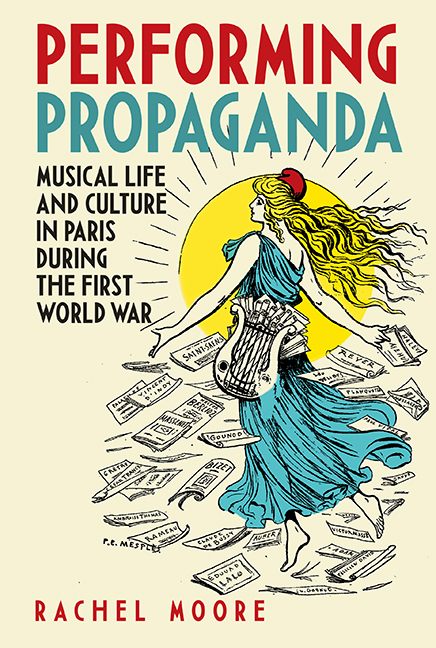 Performing Propaganda: Musical Life and Culture in Paris during the First World War
Performing Propaganda: Musical Life and Culture in Paris during the First World War Book contents
- Frontmatter
- Contents
- List of Illustrations
- List of Tables
- Acknowledgements
- List of Abbreviations
- Introduction
- 1 Musical Institutions on the Home Front
- 2 The Origins of Wartime Musical Propaganda: From the Written Word to Performing Globetrotters
- 3 Saint-Saëns's Germanophilie as a Propaganda Prototype
- 4 Propaganda on the Concert Stage: The Matinées Nationales
- 5 Creativity and Compromise at the Opéra
- 6 Music Publishing and the Édition Française de Musique Classique
- Conclusion
- Bibliography
- Index
- Miscellaneous Endmatter
- Frontmatter
- Contents
- List of Illustrations
- List of Tables
- Acknowledgements
- List of Abbreviations
- Introduction
- 1 Musical Institutions on the Home Front
- 2 The Origins of Wartime Musical Propaganda: From the Written Word to Performing Globetrotters
- 3 Saint-Saëns's Germanophilie as a Propaganda Prototype
- 4 Propaganda on the Concert Stage: The Matinées Nationales
- 5 Creativity and Compromise at the Opéra
- 6 Music Publishing and the Édition Française de Musique Classique
- Conclusion
- Bibliography
- Index
- Miscellaneous Endmatter
Summary
THE FRONT cover of this book features an image taken from the first issue of the Bulletin musical, a fledgling periodical which launched in October 1918. The publication's stated aim was to ‘collaborate in the distribution of French musical works abroad’, and its appearance in both French- and Spanish-language editions reflects its target of reaching a specifically Latin American readership. The image adorning the cover of the maiden issue depicts Marianne, the national emblem of France, with a lyre attached to her flowing robes, dancing under the sun and scattering pages of musical scores as she goes. On the surface, the image encapsulates the story of wartime musical propaganda, in which music was disseminated nationally and internationally via performance and text in order to promote French culture. But the image only presents part of the story: the scores which Marianne distributes on her travels are – perhaps unsurprisingly – exclusively French, including works by Rameau, Grétry, Méhul, Massenet, d'Indy, and Debussy. Yet, as many of the case studies in this book have demonstrated, French musical propaganda during the war relied heavily on a body of Austro- German works from the eighteenth and nineteenth centuries. These were the works which dominated concert life in particular, and they were the works which the public wanted to hear.
The ‘amnesty’ for Austro-German works classed as ‘universal’ allowed them back onto concert programmes as early as 1915. This represented a return to pre-war traditions and was perhaps a comforting sign that Paris was returning to some sense of ‘normality’; but it also meant that it was always going to be an uphill struggle to counter the influence of Austro-German works against French music. A similar situation was present in music publishing. In attempting to publish rival series of editions of the corpus of works so central to European musical life, the French lagged behind their competitors from across the Rhine, who had been engaged in such endeavour for decades. Whilst a single edition worked on cooperatively by publishers across the country aimed to solve the problem, the scale of the gap soon revealed the impossibility of the collective project: Austro-German publishers had already had plentiful time to both penetrate the French market and cement their reputation internationally.
- Type
- Chapter
- Information
- Performing Propaganda: Musical Life and Culture in Paris during the First World WarMusical Life and Culture in Paris during the First World War, pp. 217 - 220Publisher: Boydell & BrewerPrint publication year: 2018
